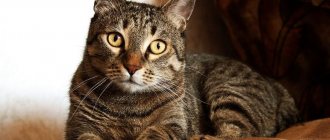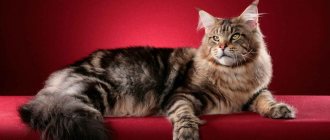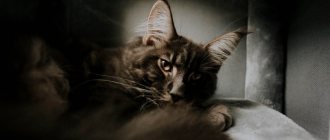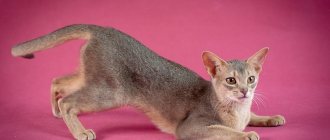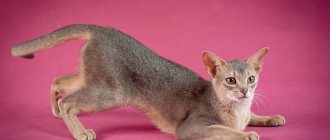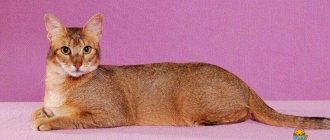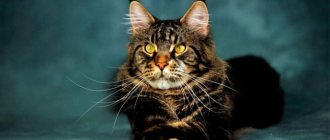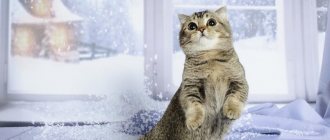Large sizes, tufts on the tips of the ears and other striking differences from other cats have given rise to many legends and myths about the appearance of Maine coon seals.
There are several assumptions related to the history of the origin of the Maine Coon breed - there are both romantic variations, largely based on the appearance of the animals, and scientific theories put forward by zoologists.
The future owner is recommended to first learn as much as possible about the pet - where the name of the breed came from, how Maine Coons developed not only in Europe, but also in Russia.
History of the origin of the breed
In the vastness of our country, a similar breed appeared quite recently, about 20 years ago or a little more. This happened when the well-known “Iron Curtain” fell and a mass of different, hitherto unknown breeds of cats and dogs headed towards us. The Maine Coon breed was no exception.
Interesting to know! If you believe the legend, then at one time there was a Captain Kun who preferred to travel with large long-haired cats. During the next voyage, some cats ran away from the deck of the ship, which contributed to the appearance of Maine Coons in various countries.
According to some information, the breed was first shown at an exhibition in Boston, after which the breed was forgotten for a long time, and undeservedly.
And yet, English farmers made a lot of efforts to preserve this amazing breed, which, in its breed characteristics, pointed to the American raccoon cat. Several decades ago, on the Isle of Man, which belongs to the English kingdom, a special coin was issued dedicated to the Maine Coon cat breed.
The breed today
Marble tabby color
At first, only the color “black marble” was recognized. But later the standards became more and more lenient. Today all color variations are recognized. The breed experienced a surge of curiosity and recognition, then interest in big cats faded. The second round of popularity began in the mid-twentieth century. Today the breed is among the top five.
Maine Coons appeared in Russia in the early nineties. Over the years, many nurseries have appeared, releasing thousands of kittens into the world. We can say with confidence that cats with a unique history are not going to give up their position.
Interest in unusual cats is growing - who wouldn’t want to own a large predator shrouded in a mysterious origin story?
Maine Coon: description
The cat family today is quite variegated and numerous, which indicates a variety of breeds. Among this family, the Maine Coon breed stands out noticeably, which is distinguished by its impressive size, rather fluffy and thick hair, as well as an unusually fluffy tail. The unique appearance, as well as the peaceful disposition, allowed this breed to become a very popular pet, both abroad and in our country.
Breed standards
The main breed standards include the following data:
- The head is massive with an elongated skull. The ears are set high, so they are clearly visible, with clearly defined tufts.
- The eyes are oval-shaped and widely set, with irises of golden, amber or green shades.
- The body is powerful and quite large, which is not typical for domestic cats.
- The paws are quite large, and hairs stick out between the pads.
- The tail is long and fluffy, and its end reaches the shoulder girdle of the animal.
- The coat is just as thick and very fluffy.
- In the neck area there is a clearly defined “mane”, and on the “pants” you can see abundant undercoat.
- The coat color can be very diverse, including marbled and tortoiseshell, not counting shades of red, white and black.
- An adult cat can weigh from 7 to 15 kilograms.
- An adult cat weighs no more than 6 kilograms.
The above characteristics indicate that this breed is noticeably different from other cat breeds. Thanks to this uniqueness, cats of this breed are very popular among both foreign and domestic breeders.
Maine Coon cat personality
Despite such a serious and impressive appearance, the Maine Coon breed is characterized by a rather peaceful and sociable character. In addition, the animal gets along without problems with many pets if they have the same, non-aggressive behavior.
It is important to know! As a rule, the nature of the behavior of such an animal is better defined within certain boundaries as a result of proper upbringing. This must be done from an early age of the kitten, giving it enough time and attention.
Kittens of this breed are characterized as very active, so they love various outdoor games. In addition, their hunter instinct begins to manifest themselves quite early. Despite its large size, this breed grows and develops quite slowly. In this regard, the breeding process begins after 4 years of the animal’s life.
Lifespan
Foreign scientists, based on animal life insurance data, have come to the conclusion that the average life expectancy of Maine Coons is between 12-13 years. Despite this, some individuals (almost half) lived up to 16 years, or even more, but with proper care and maintenance.
MAINE COON - INTERESTING FACTS ABOUT ANIMALS
Origin legends
Maine Coons are classified as aboriginal breeds. These cats were not specially bred, but appeared as a result of natural mixing of other breeds. This process occurs under the influence of natural selection, when the strongest individuals survive and produce offspring. They appeared in America, in Maine, where they lived for a long time in the vicinity of local farmers.
Maine Coons helped people by destroying rodents in barns, and for this, local residents highly valued them. As for the exterior, Maine farmers were not interested in it. For them, only the working qualities of these cats were important. But where did Maine Coons come from in America? Or maybe they originally lived there and are natives of these places?
Homeland Atlantis
There is a fantastic hypothesis that the ancestors of the Maine Coons once lived in the north of this sunken continent. When Atlantis split, the miraculously surviving large cats, similar to a lynx, were divided into three populations, which gave rise to new, now well-known breeds:
- Cats that settled in Russia eventually began to be called Siberian.
- The Scandinavian population gave rise to the Norwegian Forest breed.
- The same cats that settled in the mountainous regions of North America were allegedly the ancestors of the Maine Coons.
Sea route
This hypothesis is related to the version that it was not Columbus who was the first European to see the shores of America, but the Vikings. These brave sailors allegedly brought large and fluffy cats to the New World, which they kept on ships to fight rodents. Other researchers believe that the ancestors of the Maine Coon came to America on the ships of the Phoenicians, who were experienced sailors and were not afraid to embark on long journeys. Their ships could also carry large fluffy cats, whose main purpose was to exterminate rats and mice.
If the likelihood of contacts between the inhabitants of Ancient America and the inhabitants of Eurasia is proven by scientists, this hypothesis may not be so implausible.
For now, this version is nothing more than an unconfirmed scientific speculation.
Relationship with raccoon and lynx
The external similarity of Maine Coons with a lynx and a raccoon gave rise to the legend that these cats were born as a result of interspecific crossing.
And they are the fruit of love between the common domestic purr and the North American lynx or even a raccoon.
The first of them, as the creators of these speculations believed, is evidenced by the tufts on the ears of representatives of this breed.
And in favor of the second - a luxurious fluffy tail and a color similar to a raccoon. However, none of the scientists have ever even considered these two versions seriously, since the species differences in these animals are too large and interspecific crossing between them is simply impossible.
Maria - Antoinette
After a revolution occurred in France in 1789 and the royal power was overthrown, Louis XVIII, along with his entire family, wanted to flee the country. His wife, Queen Mary Antunette, who was a great lover of fluffy cats, ordered six of her favorites, presumably of the Angora breed, to be loaded onto the ship.
The escape was unsuccessful: the former king and queen were detained on the way to the port where the ship was waiting for them, and sent first to prison, and later to the guillotine. Samuel Cloa, the captain of the sailing ship on which the royal family was going to go to the New World, was forced to flee persecution to America. Marie-Antoinette's cats, which remained on the ship, ended up in Maine, where, crossing with local purrs, they became the ancestors of semi-long-haired cats with tufts on their ears.
Captain Kuhn
According to this hypothesis, large and fluffy cats were brought to America by an English captain nicknamed, or perhaps named Coon.
This man was supposedly known to be a cat lover.
There were many of them on his ship and, of course, kittens appeared periodically.
Some of these babies remained in the New World, as the captain often gave them away to local residents in the ports where he stopped. The new owners said that they got the kittens from “Raccoon” - that’s how the captain’s surname is translated.
Perhaps this version gave rise to the hypothesis that Maine Coon cats were bred by crossing an ordinary cat with a raccoon.
Apparently, people simply took the phrase “kittens from Raccoon” too literally and, thus, gave rise to a completely different legend about the origin of Maine Coons.
Young Tom Kun
According to this version, the ship on which Tom Kuhn served as a cabin boy once stopped near the Tarbox farm in Maine. The young man sold several long-haired cats that lived on the ship, or perhaps kittens from them, to the owners of this farm. These animals became the ancestors of modern Maine Coons. And their owner, the mistress of that very farm, became the first breeder of raccoon cats in the world.
Maintenance and care at home
Firstly, you should take into account the fact that this is a large breed, so it needs a little more living space. Based on this, arranging a cat's corner for a pet requires a serious approach, since it determines how much the animal will be provided with the opportunity to burn calories. If an animal is deprived of the opportunity to spend time actively, it will quickly begin to gain excess weight, which can provoke the development of various ailments. As a rule, the life expectancy of a pet directly depends on this.
In order for an animal to please family members for many years, it must be provided with the following accessories:
- Pukhoderka.
- Non-metallic comb with wide teeth.
- Massage, non-metallic brush with antistatic coating.
- Shampoo-conditioner.
- Bath terry towel.
- Nail clippers or special tweezers.
- A special toothbrush and toothpaste.
- Ear cleaning solution or sterile petroleum jelly.
- With cotton swabs and regular cotton wool.
Maine Coons are one of the few breeds that respond well to being walked on a leash, so they can be walked like dogs. It is also necessary to take care of the safety of the animal by timely vaccination, as well as quarterly deworming. This is especially true if there are other pets in the house.
Important point! By walking a pet, the owner unwittingly exposes it to the risk of infection with ectoparasites.
Care and hygiene
As a rule, mandatory care and hygiene measures include monitoring the oral cavity, eyes and ears. That's why:
- Experts recommend removing natural discharge from the eyes daily using a damp cotton swab.
- Clean your ears regularly using special solutions or sterilized petroleum jelly.
- Once a month, ears are cleaned using cotton swabs, taking precautions.
- When feeding with dry factory food, teeth are brushed once a month, and in the case of feeding with natural food, then at least once every 2 weeks.
Due to the fact that the breed is distinguished by the presence of long and fluffy hair, it is necessary to properly and regularly groom it. The cat will have to be bathed once a week, and it is better to accustom the animal to such water procedures from an early age.
Interesting fact! Maine Coons generally take well to water procedures, so there should be no problems with bathing. The animal is also bathed immediately before being shown at an exhibition, as well as during periods of molting.
It is advisable that the animal be bathed with its ears closed. To do this, they can be covered with cotton swabs. Bathing should be carried out using special detergents designed for bathing animals with long hair. At the same time, we should not forget about the fluffy and long tail of the Maine Coon. After applying the detergent and evenly distributing it over the surface of the coat, the soap suds are thoroughly washed off several times with plenty of water. The use of special conditioners allows you to obtain a much better appearance of wool. In addition, this will make the process of combing the animal easier.
What to feed
The diet of this breed should be approached very responsibly, taking into account the active metabolism, as well as the weight of the animal. It is very important that the diet is balanced in all nutritional components. In this case, it is advisable to give preference to ready-made factory feed of the highest class. Such, for example, as:
- Royal Canin;
- Eukanuba;
- Eagle-Pack;
- Nutro;
- Hills.
Dry factory food can be combined with canned wet food from the same foreign manufacturer. It is not recommended to feed your animal a mixture of food from different brands. Before purchasing such food rations, it is a good idea to familiarize yourself with the contents of the package. It is very important that the content of plant components is minimal.
You need to know this! When feeding natural food, it is necessary that the percentage of meat in the Maine Coon's diet is at least 75 percent. The missing 25 percent of the diet should be diluted with eggs, liquid cereals, vegetables, seafood, and dairy products.
It is very important that the Maine Coon’s diet includes greens, as well as vitamin and mineral supplements. If there is no need, then switching an animal from feeding on natural ingredients to feeding on ready-made commercial diets does not make sense, and is not recommended. In addition, it is not advisable to mix diets from different manufacturers.
Nutrition for purebred cats. Maine Coons
Diseases and breed defects
As a rule, this breed has a good, stable immune system, so Maine Coons are considered healthy and hardy animals. They tolerate well even the conditions of colder climatic zones.
The most serious diseases are:
- Heart problems associated with hypertrophic cardiomyopathy, which develops against the background of autosomal dominant hereditary processes. As a rule, such problems are observed in middle-aged and elderly animals. As the disease progresses, swelling of the pulmonary tissues occurs with sudden paralysis of the hind limbs. After such negative processes, the death of the animal occurs.
- Wall muscular atrophy appears in kittens three to four months of age and is caused by genetic factors. When moving, the animal's back part of the body sways, which with age becomes an obstacle to the animal easily jumping onto various objects located at a height.
- Hip dysplasia, which can affect both joints at the same time. It is considered a genetically determined disease that makes the animal inferior. As a rule, older animals suffer and in the initial stages it manifests itself in the form of noticeable lameness.
Polycystic renal disease is also considered a hereditary disease, although it occurs quite rarely. Such diseases or predisposition to them are determined as a result of genetic testing.
Appearance
The appearance of the glorious Maine Coon family was significantly influenced by the climate of Maine: it is very difficult to survive in the cold and snowy continental winter without a thick undercoat. A wide paw, protected by additional tufts of fur, is also a useful device that helps to slide along the ice crust without falling into the snow.
Well, its impressive size is an invaluable advantage when hunting small animals. As for modern representatives of the breed, their appearance could not help but be affected by the passion of European breeders for extremism. Today's Maine Coons have significantly increased in size, their faces have become even more elongated, and their ears have grown significantly.
Head
The Maine Coon's muzzle
is massive, noticeably elongated in length, with a relief profile, high cheekbones and a medium-length nose. Since the ancestors of modern Maine Coons hunted rodents, they often had to “dive” into holes for prey, which became the main prerequisite for the formation of a somewhat elongated skull shape.
Eyes
The eyes are round in shape, set wide and slightly oblique. The shade of the iris varies from green to rich yellow and is in harmony with the color of the animal.
Ears
Large in size, with a wide base and a slight forward tilt. A distinctive feature is the “lynx tassels” and “brushes” peeking out from the ear flap. It was the outstanding size of the ear that helped Maine Coons become excellent mousecatchers, for which the breed is especially loved by American farmers.
The skin on the ears is thick, protected by thick hair, and the cartilage structure is dense. To maximize heat retention and protect the hearing organs, coons use an ancient technique: the animal presses its ears tightly to its head, as if folding them, which prevents icy air from penetrating inside the funnel.
Neck
Maine Coon kitten The
neck of Maine Coons is strong, muscular, of medium length, decorated with lush and long hair. Among breeders, individuals with a neck “collar” reaching to the ear flaps are especially valued.
Body
Elongated, close to a rectangle in shape, with well-developed muscle mass. The chest is quite wide, the shape of the back is horizontal.
Limbs
Tall, muscular and very strong. Set wide apart.
Paws
Massive, round in shape, protected by a dense “edge”.
Tail
The Maine Coon's tail is long (equal in size to the length of the body), with a wide base, without kinks. Covered with thick hair, under which a dense, water-repellent undercoat is hidden. In extreme weather conditions, the tail acts as a natural heater: the animal wraps it around the body, thereby protecting itself from the cold.
Wool
The Maine Coon's coat is long (from 10 to 15 cm), but uneven, gradually increasing in volume from the shoulders to the belly. The most luxuriant wool is in the area of the so-called “pants”. In the dorsal area, the cover is more rigid with a predominance of guard hairs. The belly and sides are protected by a soft downy undercoat, the main purpose of which is warming and water-repellent.
Color
A Maine Coon drinks tap water.
Individuals bred in nurseries in different countries can vary quite a lot in both color and size. Recently, cats of any color are allowed to participate in exhibitions, with the exceptions of point, lilac and chocolate. At the same time, the classic “identifying shades” of coons are considered to be agouti, brindle black, marbled black and white (the latter option is widespread in Russia).
Possible defects
If a Maine Coon's appearance does not conform to generally accepted standards, it automatically excludes it from the ranks of the show class. In other words, such individuals are barred from entering exhibitions.
Reasons for “excluding” a cat from participating in all kinds of competitions may be insufficiently fluffy fur in the belly area, too short a tail, small size of the animal, spots and specks on the fur, a relief shape of the nose (the presence of a noticeable depression in the middle), wide-set ears, uniform length of fur throughout the body.
A genetic anomaly such as polydactyly (the presence of an excess number of toes on a cat’s paws) is also considered a significant reason for banning an animal from participating in public events. At one time, this mutation was widespread among Maine Coons, which is why it received the status of the main defect of the breed.
Buy a Maine Coon: tips and tricks
According to FIFE rules, breeders must sell kittens at least 3 months old, although they can be put up for sale earlier, from the age of one month.
This allows the buyer to observe the animal for 2 months. In other words, you can reserve your Maine Coon in advance. As a rule, experienced breeders do not sell kittens unless they have behavioral skills and are not fully socialized.
Where to buy, what to look for
To buy a Maine Coon kitten, it is better to contact experienced breeders or a specialized nursery. In this case, you should pay attention to the fact that all documents that relate to both the kitten’s parents and their offspring are presented.
The documents must indicate:
- The pedigree of the parents, the nature of their behavior and temperament, the exact number of matings, as well as health data.
- Features of the kitten’s behavior, as well as behavioral skills, including health status.
If necessary, nursery staff or an experienced breeder should give appropriate recommendations or advice on maintenance, care, and diet. It is very important at this stage to decide on the diet, since it is not advisable to change it at all for a kitten at this age. If you plan to further show the animal at exhibitions, then it is advisable to purchase a purebred animal with all accompanying documents and a veterinary passport.
Maine Coon cat price
This is a fairly expensive cat breed, so even pet-class kittens cost at least 15 thousand rubles. Breeding class kittens, as a rule, cost at least 40 thousand rubles, regardless of the region. The most prestigious “show” class generally costs crazy money. You will have to pay about 95 thousand rubles for it.
Important point! If you order kittens from foreign nurseries, their cost will largely depend on expensive delivery. Therefore, you can count on a fairly tidy sum.
Care
All large breed animals have the same problem - the condition of the bones and joints. To prevent your Maine Coon from experiencing such troubles, he must receive vitamin supplements with calcium and potassium and have regular exercise.
Since this breed is long-haired, the cat needs to be given a paste that cleanses the stomach of hairballs. You need to brush your cat a couple of times a week.
Otherwise, caring for a Maine Coon is the same as for regular cats. Regular vaccinations, parasite removal, ear and eye cleaning are required.
Owner reviews
Many owners note the fact that Maine Coon cats embody the best that is possible in relation to cats. These are animals with very aristocratic behavior that require appropriate attention to themselves. In addition, the cat is strong and graceful, but at the same time good-natured and affectionate. She treats both her owner and the rest of the family with love, and is devoted to them for life.
Adult Maine Coons are not known for making sounds when needed and not needed, but if a cat wants to play with its owner, it will definitely remind you of this by making original sounds. Unlike the sounds that other breeds of cats make, Maine Coons produce sounds with a characteristic vibrating timbre. If there is no need, the animal does not make sounds or makes sounds, but very rarely. It is noted that the timbre of their voice does not in any way correspond to their appearance and, especially, their size.
Enthusiasts who practice breeding of this breed monitor the preservation of the main characteristics of the breed, and also popularize this breed in our country. In this regard, they quite often travel abroad with their pets to find a worthy pair with the appropriate breed characteristics. This factor has a significant impact on the cost of kittens, although, as practice shows, this is quite reasonable and worth it.
Where did the name come from?
The period of development of the Maine Coon breed remained without substantiated documentary evidence. But it is certain that it was only in Maine that these four-legged domestic hunters first formed a large population and became the predecessors of the modern group. And their similarity with the local species of raccoons only served as the reason for the future common name of the entire breed.
By now, giants have taken pride of place among the three most popular varieties of cats among Americans, and their European branch does not go unnoticed on the Old Continent.
Everything about this memorable giant is attractive - from his kind and sociable character to almost dog-like devotion and desire to serve the owner.
The large size and rich fur of the Maine Coon have served another useful purpose - lovers of fashionable living toys are not very fond of this breed of cat. They take up too much space and during molting they can cover floors, sofas and carpets with a thick layer of hair. But if a good-natured Maine Coon appears in an apartment, then the routine in it immediately changes.
No owner can resist setting aside a couple of hours a day to communicate with this unique cat with the coloring of a raccoon, the tufts on her ears from a predatory lynx, and the character and habits of a dog.
Character traits
At first glance, the unrealistically large size, meaningful look and luxurious fur are striking, although this is not all that can attract a person’s attention. People who are the owners of these animals can talk about their pet for quite a long time and surprise the interlocutor.
Cats play like little kittens, with enthusiasm, and during games they look funny and it is impossible to watch them without smiling.
And when the owner is doing some kind of work and is particularly busy with it, his pet will not leave this matter unattended and will definitely go to “help”. The cats will remain nearby throughout the entire activity, or until the work is completed.
When people come to visit, they are afraid at the sight of a large animal and often think that they will be attacked and at least scratched. But all this is in vain, they are very gentle and affectionate, they love peace, and can meet anyone with a perky purr.
The Maine Coon grows from 3 to 5 years, and small kittens are very easy to train.
Earlier it was said that they are hunters and therefore it is advisable to make a tree for them at home to make their well-being more comfortable. It is recommended to calculate such a structure based on the maximum weight of the animal when making it yourself or purchasing it at a pet store.
Its presence in the interior is necessary for sharpening claws, climbing and various games. It is desirable for cats to have an individual space where no one will disturb them. Having matured, Maine Coons do not play with the same passion as little kittens, they are lazier, but, nevertheless, their interest in observing events does not go away.
Sometimes the desire to run and frolic also attacks adult animals, so they need a specially allocated place, taking into account their large size. If you give them a tasty piece to eat, for example, a chicken breast, then they don’t eat it all right away, but after trying a piece, they begin to play with it, pushing it far under the furniture, where possible. During the game, they can perform various virtuoso acrobatic exercises and tricks, and you can watch them throughout the entire show.
These cats amaze with their self-confidence and self-esteem. They do not have the habit of climbing on the table and stealing food, even if they are hungry, they will never even ask for food, because they have a sense of pride from birth.
They find a common language with representatives of other animals, and communication is successful, despite their natural pride. They also respect dogs and do not react to their approach by hissing and ruffling them, like ordinary cats.
But if there are mice or rats at home, then we can assure you with one hundred percent certainty that soon there will be none left, because Maine Coons are excellent hunters.
If the house is filled with flies or midges, then there is no doubt that the cats will catch them all. They can simply look at the birds from the window without making any attempt to catch them. In addition, if a cat was raised with other representatives of small animals, then he is accustomed to them, so they do not need to be afraid of him. Maine Coons are also indifferent to aquarium fish.
And here is another difference from ordinary cats: they never meow, but utter sounds that, due to inexperience, cannot be distinguished from human ones. When cats say something, you can hear the difference in the shades of their voices, so many owners understand what their favorite cat is talking about. And another revealed fact is that they are intellectuals and understand their owners perfectly, they never wake them up in the morning, even if they are very hungry.
No less noticeable is such a character trait as accuracy. For example, if something is spilled on the floor, the cat will definitely go around it so as not to get dirty. They can go to bed in any place, and the positions taken at this time can be unimaginable and masterly, which cannot but cause surprise in any person who sees it.
Many owners of this breed claim that their pet knows much more than the owner how things are in the house. Since Maine Coons are smart and naturally well-mannered, they are distinguished by their intelligence.
There is no need to spend a lot of time for the training process, since the animal understands words perfectly. Many people believe that these cats are smarter than some people.
Pros and cons of the breed
Features of Maine Coons are activity and activity, which is how they differ from other breeds. And also a serious, sometimes stern look, which absolutely does not correspond with a good character.
The breed still has many advantages:
- Maine Coon is first and foremost a companion;
- high level of intelligence, so it’s interesting to communicate with a cat;
- easy to learn;
- ability to get along with other pets;
- soft, non-conflict character;
- intelligence;
- devotion to the owner;
- nobility.
Disadvantages include excessive vigilance. A cat instantly reacts, for example, to a sharp unexpected sound or movement and can climb into a shelter somewhere very high.
Appearance
These are large cats, with a square head shape, a wide front part of the body and a long body. The tail is quite wide, taking up approximately half the cat's total length.
The head is usually elongated and rectangular. The whisker pads are noticeably developed. The profile is oblong, wedge-shaped. The transition from the cat's forehead to the tip of the nose should preferably have a “ladder” shape, and the forehead itself should be noticeably developed. According to standards, the ears of this breed should be in a “standing” position, but this is not always possible, since as the animal grows, the ears also grow, and it becomes more and more difficult to keep them vertical. The eyes are elliptical in shape, widely spaced, and large.
If a cat has small eyes, then its face always looks unhappy and angry. In breeding, all colors are possible, not counting spotted ones, like Burmese and Siamese cats. Usual weight for raccoon cats: about 10 kilograms for males, and 5-6 for females.
Training and communication
Maine Coons are very sociable animals; they love to be in human company. Pets need to be raised from as early an age as possible.
The first thing cats must learn is to use the toilet, as well as a scratching post. This breed is highly trainable; they can easily be taught anything using carrots and sticks. But do not overdo it with the punishment system, otherwise the stress-prone animal will feel bad. For example, you can wean an animal from jumping on a sleeping bed or scratching a sofa using a spray bottle. The water in it should be warm, you need to splash the animal very little: do not allow the fur to be too wet so that water gets into the eyes.
Before punishing an animal for disobedience, think about whether it is to blame for the current situation. Perhaps you yourself did not take care of finding a comfortable place to sleep, or installing a scratching post or tray in an insufficiently secluded place.
Difficulties and possible illnesses
The breed is hardy and has good health, but cases of illness still sometimes occur. Among the most common diseases is hypertrophic cardiomyopathy.
Spinal muscular atrophy is also among the most common. This disease is hereditary, so the cat’s parents and their health are an important factor when buying a pet. This disease is incurable, it leads to muscle weakness and complete atrophy. Hip dysplasia is also a hereditary disease. It is characterized by severe pain and even lameness of the animal. The disease is not fatal, but it often causes osteoarthritis. To avoid these and other diseases, take your Maine Coon to the veterinarian periodically. He must monitor the health of the animal, then you will not have to worry about the well-being of your pet.
The main rule of keeping a cat is love and respect for him. Before you decide to get yourself a four-legged friend, make sure you are ready to take on this responsibility.
pets2.me
Raccoons from Maine
The history of the Maine Coon breed takes us back to the American state of Maine. It is believed that the cats got their unusual name due to their resemblance to raccoons. Indeed, in appearance, Maine Coons are somewhat similar to raccoons - in build, large tail, color. Even the sounds made by young raccoons are somewhat similar to the purring of a cat. That is why the literal translation of the Maine Coon breed from English will mean: Maine raccoon. The first word is a reference to the name of the state (we'll talk about it later), and the second is a residual from raccoon, which is exactly “raccoon”.
Let's talk about the second one right now. The main legend about the history of the Maine Coon breed is as follows: it was born after crossing a female raccoon with a cat. Well, since they are similar, then there is nothing to deny. However, cats of many other breeds also have stripes similar to raccoons. And the Maine Coon cat got its large shape through natural selection. In addition, the impossibility of interspecific crossing has been scientifically proven. So, solely the evolution of the species and neither the raccoon nor the lynx (the tasseled ears of the Maine Coon remind many of this predator) took part in the breeding of this cat breed.

